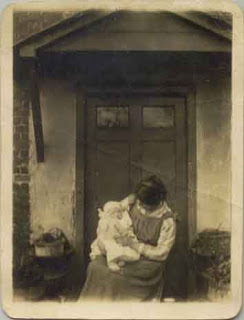I am sitting alone in an imposing Georgian terrace in Edinburgh, it is late at night on Christmas Eve 2002, in the middle of a Scottish winter. Beside me is an old black wooden box, about the size of a small travel chest, with a large lock on it. This box in known to my mother’s family as the ‘bodybox’ – a collection of family papers and photographs assembled by my grandfather. Inside is a jumble of old newspapers, letters, photographs, bills, telegrams, miscellaneous scraps of paper with names and dates, a note from a young boy to santa claus with a picture of the particular Hornby train-set that he would like for Christmas. Some of the bits of paper are annotated or dated. The Christmas request is marked “Note from Ritchie, Xmas 1936. R.Orr”. ‘Ritchie’ is my uncle Richard, ‘R.Orr’ is my Grandfather, also Richard. It is the photos that claim my attention. Most are of people that I recognise – aunts, uncles, grand parents, great-grandparents. There are some photos that are unmarked and I have no idea who these people were, and it is these photos that pique my interest.
There is a photo of a woman in a grove of tall slender trees. She wears a large black and white sun hat, a white blouse and dark full length skirt nipped in at the waist, a long strand of beads hangs down below her belt, she holds something dangling by her side – probably a purse. By her dress I would say the photo dates from around the turn of the 19th century or early 20th. The only clue is the word “Bill’s” on the back. There are two ‘Bill’s that I know of – my Grandfather’s eldest brother or the German Bill that my great aunt married.
There is another photo printed as a kind of card with rounded edges; a woman is seated outside in front of the door of a house. She is holding a baby, maybe six months old, the woman’s gaze is downwards towards the child in her arms, her face in almost fully obscured. I don’t know who this woman is, I don’t know who this baby grew up to be.
There is a photo of two young girls by the sea, the waves crashing against a rocky shoreline in the background. The girls are small figures, indistinct against the sea, cliffs and hills behind them, there faces aren’t clear enough to pick out a resemblance. Perhaps they are my great aunts as children – my Grandfather was the only child of his family to have been born in the 20th century. I could estimate the photo to be early 20th century so that might fit.
Another very old photo shows a young woman leaning up against a haystack with her face turned to the side. Her dress looks late 19th century, quite a narrow waist, a cameo choker around her neck. There is something about her face that is very familiar – the same strong brow that seems to crop up in my mother’s family, she reminds me of one of my aunts. She seems to be tolerating having her picture taken, a slight look of amusement around her mouth but also I suspect impatience. I look at this woman and she could be anyone but I wonder if she is my great grand mother as a young woman. My mother doesn’t recognise her and there is no one else to ask.
(And on the subject of old photos, I happened upon a blog called Forgotten Old Photos which tries to find homes or at least connections for old forgotten photos. What a lovely idea.)





It's terribly sad that the connection is broken, the chain of memory snapped. Makes me realise how urgent it is that I go through our family photos with my Mum and get them properly labelled, and sort out the stories from our family history, before it's too late.
ReplyDeletei know the feeling. there are scads of boxes of photos from both sides of my family in my parents' garage. my paternal grandfather took loads of kodachrome slides, too. and he died when i was about 6 or 7, and i have looked at some of them with my father, and he can only name some of the folks in them.
ReplyDeletei also have curiously become the owner of some very antique photos that belonged to a person who a friend of mine was the executor of his estate when he passed. i never knew him in life, but i have many books, classical cds he collected, and an odd assortment of interesting photos of likely his family. he had no living family as far as i know. i look at them, propped on my bookshelf, many states and moves later and wonder about these people and their lives around the turn of the last century.
Thank you for this wonderful and evocative post.
ReplyDelete